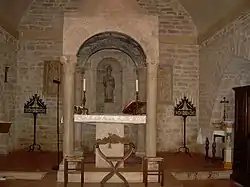San Prospero, Perugia
Chiesa of San Prospero is a religious building in Perugia, located in Via San Prospero, 7 (access also from Via Don Bosco, 5). Wheelchair accessible.[1]
| Chiesa of San Prospero | |
|---|---|
 | |
| Location | Perugia |
| Country | Italy |
| Religious institute | Catholicism |
| Architecture | |
| Years built | VII-VIII century |
| Administration | |
| Diocese | Perugia |
History and art
The first building was built between the VII and VIII century over an Etruscan-Roman necropolis and was a female monastic settlement. In 1285 became a parish Church of Porta Eburnea. In 1303 it became dependent on the Cathedral Chapter and in 1436 it on the Abbazia di Pomposa. In the XVI century, due to the badly damaged roof, it was included in a building of larger proportions and that's why, outside, it appears as a country house and up to the first half of the XX century it was used as a dependence of a farm. During the restoration works the orientation of the nave was changed and even today are still visible traces of this on the walls of the temple on the back of the Church.[1] During the XVII century, it passed to the seminary and later to the priest of the Missione; after that to the Donini's family. In 1927, after the restoration works, it was reopened for worship. Some artefacts of the ancient structure of Etruscan workmanship are still visible in the perimeter walls, and among them a funeral urn with an Etruscan inscription. The ancient wooden trusses ceiling, damaged, was replaced, in the XVI century, by a barrel vault in masonry. Inside the Church there is an ancient Lombard marble ciborium of the VIII century, with a compendium of Paleo Christian - Ravennate figurative themes mixed with those of classic derivation, like peacocks and inverted mirrors. In the presbytery a statue of San Prospero of Arnolfiano style, dating from the end of the XIII century.
_Tearie_di_Sante_in_Chiesa_di_SAN_PROSPERO_Perugia.jpg.webp)
_Seno_di_Abramo.jpg.webp)
In the only chapel on the right, frescoes by a local artist whose signature is Bonamico P., dating from 1225, re-discovered in 1910.[2] There represented: theories of Apostles, prophets and numerous saints, especially female saints, as this was a female monastery. Among the saints Prospero with pastoral and mitre surrounded by devotees frightened by Archangel Michael, sent to judge souls. Pietro Diletti, Salesian historian of art, read the painting as a representation of the Last Judgment,[3] more specifically the quote of the Gospel according to Luke: the parable of Lazarus and the rich man.[4] Heaven is represented by “Adam’s bosom”, who received the righteous in his arms. In the middle of the bosom the poor but blessed Lazarus prevented from communicating with Hell. On the right the representation of hell with the rich Epulone, fat and thirsty in the act of pointing out his parched throat. The Angel of Darkness overhangs and tries to grab a soul. On the right side of the small chapel, Sant’Ercolano, bishop and martyr, and Saint John the Baptist in the act of pointing out below to “i calzari di Cristo” (Christ's sandals). Above traces of the Annunciation. On this very wall, with the main entrance, also the Twelve Apostles, a group of Benedictine nuns and a devotee praying in the direction of the Franciscan martyr Giovanni da Perugia. All around a false-drapery decoration, of which only few fragments are left.
Medieval Art Historians Ettore Ricci and Pietro Scalpellini find in this casket some recalls to Roman Paleo Christian art: the protagonists dressed with tunic and pallium, strictly put from the front, recall the representations of ancient sarcophagi, catacomb frescoes and mosaics. Others sources for these Saints can be illuminated codes originating from Asia or France;[3] indeed the painting of Santa Maria Maddalena, only covered by hair, refers to the iconography of Santa Maria Egiziaca. It's here that, according to P. Scarpellini, this iconography of Maria Maddalena makes its first appearance in the west.
Notes
- "Chiesa di San Prospero". turismo.comune.perugia.it.
{{cite web}}: CS1 maint: url-status (link) - "San Prospero's frescoes". amici san bevignate.
{{cite web}}: CS1 maint: url-status (link) - Ricci, Ettore (1998). La Chiesa di San Prospero. p. 13.
- Luca, Vangelo e atti degli Apostoli nuovissima versione dai testi originali. AGAM Cuneo. 2007. p. 220.
References
- Ettore Ricci, La Chiesa di San Prospero a Perugoa Perugia, a cura Mario Pitzurta 1998
- Pietro Diletti, San Prospero Un Santo, una Chiesa, 2004
- Guida di Perugia, curatore Massimo Montella, Electa editori umbri, 2001
External links
- Chiesa di San Prospero; Perugia tourism